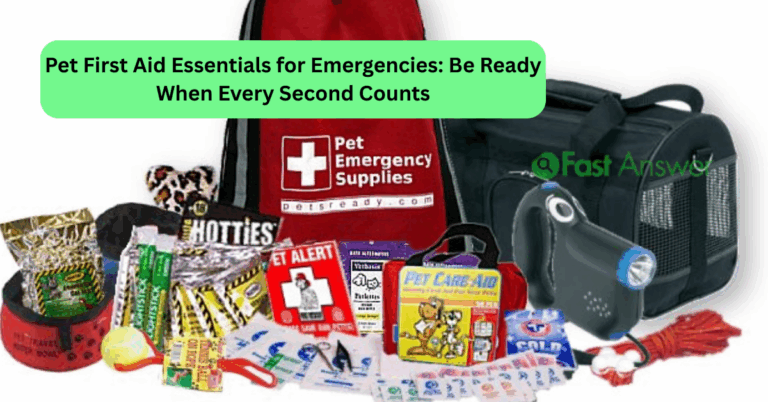How to Create a Balanced Pet Diet Plan: A Smarter Approach to Pet Nutrition and Health
Feeding your pet isn’t just about filling a bowl it’s about supporting their health, energy, and longevity through thoughtful nutrition. Learning how to create a balanced pet diet plan is one of the most important responsibilities of any pet owner. A proper diet fuels your pet’s immune system, supports growth, maintains a healthy weight, and prevents future health issues. Whether you’re caring for a playful puppy, a senior cat, or an active rabbit, this guide helps you build a tailored, nutrient-rich plan that meets your pet’s unique needs while keeping them happy and healthy.
Know Your Pet’s Nutritional Needs by Breed, Age, and Lifestyle
Every pet has specific dietary requirements based on their species, breed, age, and activity level. A large-breed dog with high energy needs will require a different feeding strategy than a small indoor cat. Likewise, a young, growing animal needs more calories and nutrients than a sedentary senior pet. Understanding these differences helps you avoid underfeeding, overfeeding, or nutritional imbalances.
Start by speaking to your veterinarian to determine your pet’s ideal weight, daily calorie needs, and any breed-specific health risks. For example, some breeds are prone to joint issues and benefit from glucosamine supplements, while others may need grain-free or low-fat options. Personalizing the diet from the beginning prevents common health problems linked to poor nutrition.
Balance Macronutrients: Protein, Fats, and Carbohydrates
The foundation of any balanced diet includes three key macronutrients protein, fat, and carbohydrates. For most pets, protein is the most important component, as it supports muscle maintenance, tissue repair, and energy. Dogs typically thrive on high-protein diets, while cats, being obligate carnivores, require even higher protein levels with minimal carbohydrates.
Fats provide essential fatty acids that support skin, coat, and brain health. They’re also a concentrated energy source, especially important for active pets. Carbohydrates can be included in moderate amounts, particularly for dogs, to support digestion and provide fiber. Choose whole-food sources like brown rice, sweet potato, or oats rather than fillers or processed grains.
Incorporate Essential Vitamins and Minerals for Long-Term Health
A truly balanced pet diet isn’t complete without the right mix of vitamins and minerals. These micronutrients regulate everything from metabolism and immunity to bone growth and nerve function. Most commercial pet foods are fortified to meet these needs, but if you’re feeding a homemade or raw diet, careful planning is essential to avoid deficiencies.
Key nutrients include calcium, phosphorus, zinc, and vitamins A, D, and E. Adding small amounts of organ meats, leafy greens, or veterinarian-approved supplements can help round out your pet’s intake. Be cautious over-supplementing can be as harmful as underfeeding, especially with fat-soluble vitamins.
Choose Between Commercial, Homemade, and Raw Diets
When building your pet’s diet plan, one of the biggest decisions is choosing between commercial, homemade, or raw food. High-quality commercial foods offer convenience and are often scientifically formulated to meet AAFCO standards. If you go this route, choose brands that list whole protein sources first and avoid artificial additives.
Homemade diets give you complete control over ingredients but require precise balance and vet guidance to ensure nutritional adequacy. Raw diets have gained popularity for their focus on fresh, minimally processed ingredients, but they carry risks such as bacterial contamination or imbalance if not properly managed. Whatever method you choose, consistency and quality should always guide your decision.
Adjust Portions and Plans as Your Pet’s Needs Evolve
Your pet’s dietary needs aren’t static they evolve with age, health status, and lifestyle changes. Puppies and kittens eventually transition to adult formulas. Active pets may slow down with age and require fewer calories. If your pet gains or loses weight, develops allergies, or experiences medical issues, the diet plan must adapt.
Weigh your pet regularly, monitor their energy, coat quality, digestion, and mood. Small changes like switching protein sources, adjusting portion sizes, or rotating in new ingredients can make a big difference. Always introduce dietary changes gradually to avoid digestive upset, and consult your vet before making major shifts to the feeding plan.
FAQ
1. Can I feed my pet human food as part of their diet?
Some human foods like cooked meats, rice, or vegetables can be safe in moderation, but always avoid toxic items like onions, garlic, chocolate, or grapes.
2. How do I know if my pet’s diet is truly balanced?
Look for consistent energy levels, healthy skin and coat, regular bowel movements, and steady weight. A vet consultation and occasional lab tests help confirm balance.
3. Is raw feeding better than commercial pet food?
Raw diets can be beneficial if done correctly, but they also carry risks. Consult a veterinary nutritionist before starting a raw feeding plan.
4. Should I add supplements to my pet’s diet?
Only if recommended by your vet. Over-supplementing can lead to toxicity or imbalances, especially with calcium or fat-soluble vitamins.
5. How often should I feed my pet?
Most adult pets do well with two meals a day. Puppies, kittens, and very active animals may require more frequent feeding, while portion control remains important.





